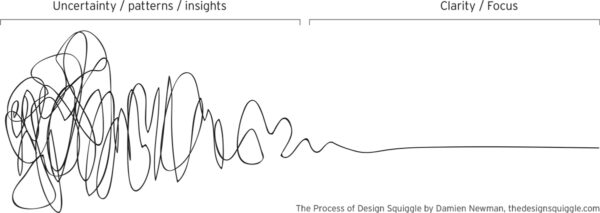What you’re looking at is called “the squiggle.” It was created by Damien Newman to describe the product design process.
I think the squiggle pretty well describes most people’s fundraising journey, too. Moving from left to right, all of us…
Start our journey careening wildly to figure out how fundraising works…
We begin to develop an understanding of how it all works…
We understand and refine our practice.
It’s good to remember that we all go through the beginning chaos.
For instance, ten years ago we had a client who had met their budget for the year by Thanksgiving. Their Board asked us, “Since we’ve already met budget, shouldn’t we stop fundraising for the year? And since we won’t be sending our year-end letter, could we mail it during next summer when we will need the money?”
After some internal snickers… we had a great conversation with the Board. Because of that conversation, the Board moved to the right on the squiggle. They’ve continued to learn and have become an incredible fundraising asset to the organization. (And they are still a client today.)
They just needed a little help from someone who was farther along on their fundraising journey.
In my own career, I’ve written about when my mentor asked me, “Why are you writing about the organization?” That was a moment of insight and I moved closer to the clarity and focus I have today.
I mention all this because we’re ALL somewhere on the squiggle. And the longer I’m on my fundraising journey, the more compassion I have for people at the start of theirs.
So in the spirit of passing it on…
If you’re in the Uncertainty / Patterns / Insights zone, what’s one thing you are doing this year that will help you move forward?
If you’re in the Clarity/Focus zone, what’s one thing you are doing to help another Fundraiser join you out there?
And wherever you are, are you compassionate towards the others on this journey with you?
The “Research,” “Concept” and “Design” labels on the bottom of the original graphic were removed to keep the point as simple as possible. Thank you to Damien Newman for allowing the graphic to be used on the Creative Commons license.









